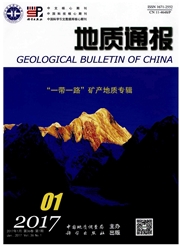

 中文摘要:
中文摘要:
西藏仲巴旧儿古湖阶地剖面厚43m,于25.4m以上产介形类化石,计6属12种。依据各属种的生态特征、化石组合变化及沉积特征,对古湖沉积环境的分析表明;约40000-36300aBP前为湖泊三角洲沉积环境,不适宜介形类等生物生存或不利于介形类壳体的保存。36900-34470aBP属湖泊边缘相沉积,湖面较宽,湖水较深,有一定的成度,介形类丰度高,属种类型多,气候暖湿。34470aBP之后末次冰期来临,气候逐渐干冷,湖泊萎缩,介形类属种与数量明显减少,尤其在30000aBP前后至18000aBP气候趋干冷,湖内生境更差;18000-10460aBP湖泊已近干涸,仅剩下耐于生存的个剐分子,说明新仙女木事件在本区有较明显的响应。而自10460aBP之后,湖内生物重又开始复苏,介形类数量和属种类型又明显增加,说明气候开始转暖,气温回升,进入全新世的暖期。
 英文摘要:
英文摘要:
The terrace section of the Jiu'er Paleolake, Zhongba, Tibet, is 43 m thick, Ostracods occur above 25,4 m depth of the section, including 6 genera and 12 species, According to their stratigraphic ranges and abundances, 4 fossil assemblages may be distinguished, Analysis of the sedimentary environment of the Paleolake based on the ecological features of the genera and species, variation in fossil assemblages and sedimentary characteristics indicates the following: Before 40000-36900 a BP there occurred a lacustrine-deltaic sedimentary environment, which was not suited to the survival of organisms such as ostracods or unfavorable to the preservation of ostracod shells, At 36900-34470 a BP lake-marginal facies sediments were deposited and the lake was relatively deep and had a relatively wide surface and a certain salinity, in which the ostracods had a high abundance and many genera and species, indicating a warm-wet climate. After 34470 a BP the last glac;,ation came, when the climate became gradually dry-cold, the lake shrank and the numbers and abundances of genera and species were greatly reduced. Especially from 30000 to 18000 a BP, the climate tended to be dry-cold and the habitat Of the lake became worse. At 18000 to 10460 a BP the lake nearly dried up and only highly drought-tolerant individual elements remained, suggesting that the Younger Dryas event had a relatively marked response in the area. After 10460 a BP organisms in the lake again began to revive and the number and generic and species types of ostracods increased noticeably, suggesting that the climate begala to turn warm, and then the lake entered the warm epoch of the Holocene,
 同期刊论文项目
同期刊论文项目
 同项目期刊论文
同项目期刊论文
 Sedimentary Characteristics and Paleoenvironmental Records of Zabuye Salt Lake, Tibetan Plateau, sin
Sedimentary Characteristics and Paleoenvironmental Records of Zabuye Salt Lake, Tibetan Plateau, sin 期刊信息
期刊信息
